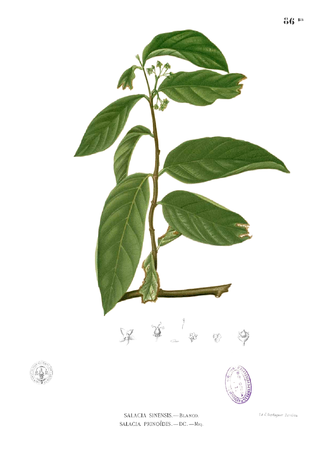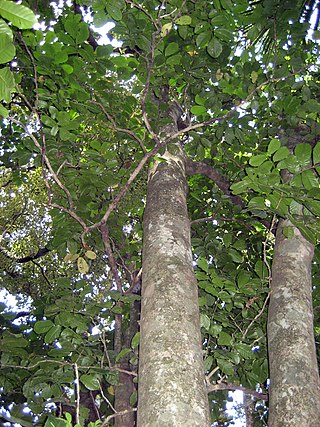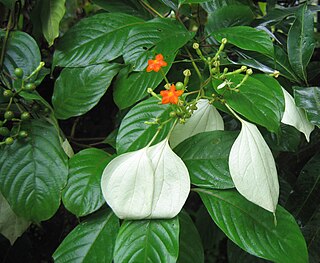
Meliaceae, the mahogany family, is a flowering plant family of mostly trees and shrubs in the order Sapindales.

Macaranga is a large genus of Old World tropical trees of the family Euphorbiaceae and the only genus in the subtribe Macaranginae. Native to Africa, Australasia, Asia and various islands of the Indian and Pacific Oceans, the genus comprises over 300 different species. It was first described as a genus in 1806, based on specimens collected on the Island of Mauritius.

Dysoxylum is a genus of rainforest trees and shrubs in the flowering plant family Meliaceae. About 34 species are recognised in the genus, distributed from India and southern China, through southeast Asia to New Guinea, Solomon Islands, and Australia. The name Dysoxylum derives from the Greek word ‘Dys’ meaning "bad" referring to "ill-smelling" and ‘Xylon’ meaning "wood".

Aglaia lawii is a species of tree in the family Meliaceae. As well as the autonym species, there are two subspecies accepted.

Canthium is a genus of flowering plants in the family Rubiaceae. They are shrubs and small trees. The leaves are deciduous and the stems are usually thorny.

Polyalthia is a genus of flowering plants in the family Annonaceae. There are approximately 90 species distributed from Africa to Asia and the Pacific.

Salacia is a genus of plants in the family Celastraceae. They are woody climbers naturally found in tropical regions.

Didymocheton is a genus of flowering plants in the family Meliaceae. It includes 41 species which range from eastern India through Indochina and southern China to Malesia, Papuasia, eastern Australia, New Zealand, and the South Pacific.

Rocaglamide is a natural product which belongs to a class of molecules called flavaglines. This compound was isolated in 1982 by King, Ming-Lu (金明儒) and colleagues based on its antileukemic activity. The name of Rocaglamide is named from two parts: Roc- and aglamide. Roc- means Republic of China (中華民國), the place in which this product isolated; aglamide indicates this product is isolated from Large-leaved Aglaia. Like other flavaglines, rocaglamide displays potent insecticidal, antifungal, anti-inflammatory and anticancer activities. Rocaglamide A (RocA) inhibits eukaryotic translation initiation by binding to the translation initiation factor eIF4A and converting it into a translational repressor.

Flavaglines are a family of natural products that are found in plants of the genus Aglaia (Meliaceae). These compounds are characterized by a cyclopenta[b]benzofuran skeleton. In 1982 King and colleagues discovered the first member of this family, rocaglamide, based on its antileukemic activity. Since then, about 50 other flavaglines have been characterized. These molecules display strong insecticidal, antifungal, anti-inflammatory, neuroprotective, cardioprotective and anticancer activities. In mouse models of cancer, flavaglines enhance the efficacy of chemotherapies and also alleviate the cardiac adverse effect of these chemotherapies.

Mussaenda is a genus of flowering plants in the family Rubiaceae. They are native to the African and Asian tropics and subtropics. Several species are cultivated as ornamental plants.

Chisocheton is a genus of trees in the family Meliaceae. The genus name comes from the Greek schizos and chiton meaning "split tunic", referring to the lobed staminal tube of C. patens. Their range is from India and tropical China, throughout Malesia and south to New South Wales and Vanuatu.











